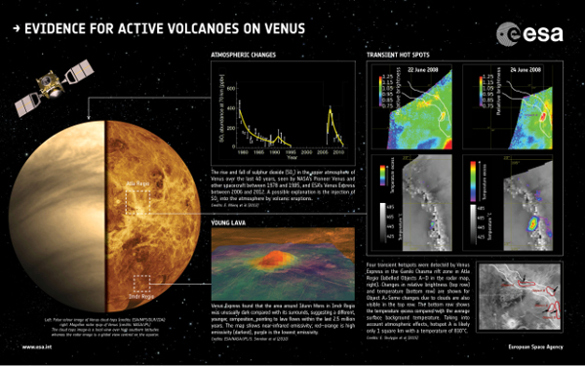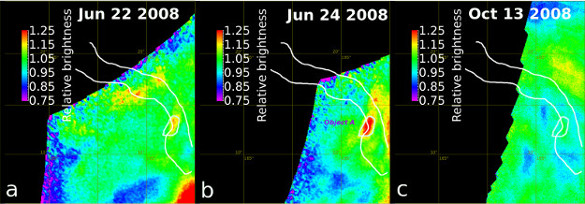Hot lava flows discovered on Venus
18 June 2015
ESA's Venus Express has found the best evidence yet for active volcanism on Earth's neighbour planet.
 |
| Evidence for active volcanoes on Venus. Credit: ESA |
Seeing the planet's surface is extremely difficult due to its thick atmosphere, but radar observations by previous missions to Venus have revealed it as a world covered in volcanoes and ancient lava flows.
Venus is almost exactly the same size as Earth and has a similar bulk composition, so is likely to have an internal heat source, perhaps due to radioactive heating. This heat has to escape somehow, and one possibility is that it does so in the form of volcanic eruptions.
Some models of planetary evolution suggest that Venus was resurfaced in a cataclysmic flood of lava around half a billion years ago. But whether Venus is active today has remained a hot topic in planetary science.
ESA's Venus Express, which completed its eight-year study of the planet last year, conducted a range of observations at different wavelengths to address this important question.
In a study published in 2010, scientists reported that the infrared radiation coming from three volcanic regions was different to that from the surrounding terrain. They interpreted this as coming from relatively fresh lava flows that had not yet experienced significant surface weathering. These flows were found to be less than 2.5 million years old, but the study could not establish whether there is still active volcanism on the planet.
An additional piece of evidence was reported in 2012, showing a sharp rise in the sulphur dioxide content of the upper atmosphere in 2006–2007, followed by a gradual fall over the following five years. Although changes in wind patterns could have caused this, the more intriguing possibility is that episodes of volcanic activity were injecting vast amounts of sulphur dioxide into the upper atmosphere.
Now, using a near-infrared channel of the spacecraft's Venus Monitoring Camera (VMC) to map thermal emission from the surface through a transparent spectral window in the planet’s atmosphere, an international team of planetary scientists has spotted localised changes in surface brightness between images taken only a few days apart.
 |
| Brightness changes in Ganiki Chasma. Image courtesy of E.V. Shalygin et al. (2015) |
"We have now seen several events where a spot on the surface suddenly gets much hotter, and then cools down again," says Eugene Shalygin from the Max Planck Institute for Solar System Research (MPS) in Germany, and lead author of the paper reporting the results in Geophysical Research Letters this month.
"These four 'hotspots' are located in what are known from radar imagery to be tectonic rift zones, but this is the first time we have detected that they are hot and changing in temperature from day to day. It is the most tantalising evidence yet for active volcanism."
The hotspots are found along the Ganiki Chasma rift zone close to the volcanoes Ozza Mons and Maat Mons. Rift zones are results of fracturing of the surface, which is often associated with upwelling of magma below the crust. This process can bring hot material to the surface, where it may be released through fractures as a lava flow.
"These observations are close to the limits of the spacecraft's capabilities and it was extremely difficult to make these detections with Venus' thick clouds impairing the view," says co-author Wojciech Markiewicz. "But the VMC was designed to make these systematic observations of the surface and luckily we clearly see these regions that change in temperature over time, and that are notably higher than the average surface temperature."
Because VMC's view is blurred by the clouds, the areas of increased emission appear spread out over large areas more than 100 km across, but the hot regions on the surface below are probably much smaller. Indeed, for the hotspot known as 'Object A', the team calculate that the feature may only be around 1 square kilometre in size, with a temperature of 830 °C, much higher than the global average of 480 °C.
The Ganiki Chasma rift zone was already considered to be one of the most recently geologically active regions on the planet, and as the new analysis suggests, it is still active today.
"It looks like we can finally include Venus in the small club of volcanically active Solar System bodies," says Håkan Svedhem, ESA's Venus Express project scientist.
"Our study shows that Venus, our nearest neighbour, is still active and changing in the present day – it is an important step in our quest to understand the different evolutionary histories of Earth and Venus."
Notes for editors
"Active volcanism on Venus in the Ganiki Chasma rift zone," by E.V. Shalygin et al is published in Geophysical Research Letters. DOI: 10.1002/2015GL064088
For more information, please contact:
Markus Bauer
ESA Science and Robotic Exploration communication officer
Tel: +31 71 565 6799
Mob: +31 61 594 3 954
Email: markus.bauer![]() esa.int
esa.int
Eugene Shalygin
Max Planck Institute for Solar System Research, Germany
Email: shalygin![]() mps.mpg.de
mps.mpg.de
Wojciech Markiewicz
VMC principal investigator
Max Planck Institute for Solar System Research, Germany
Email: marko![]() mps.mpg.de
mps.mpg.de
Håkan Svedhem
ESA Venus Express project scientist
Email: Hakan.Svedhem![]() esa.int
esa.int




